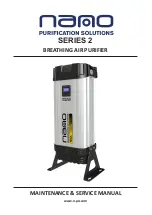
12
GB
6.4. Connecting remote controller, indoor and
outdoor transmission cables (Fig. 6-3)
• Connect indoor unit TB5 and outdoor unit TB3. (Non-polarized 2-wire) The “S”
on indoor unit TB5 is a shielding wire connection. For specifications about the
connecting cables, refer to the outdoor unit installation manual.
• Install a remote controller following the manual supplied with the remote
controller.
• Connect the remote controller’s transmission cable within 10 m using a 0.75 mm
2
core cable. If the distance is more than 10 m, use a 1.25 mm
2
junction cable.
1
MA Remote controller
• Connect the “1” and “2” on indoor unit TB15 to a MA remote controller. (Non-
polarized 2-wire)
• DC 9 to 13 V between 1 and 2 (MA remote controller)
2
M-NET Remote controller
• Connect the “M1” and “M2” on indoor unit TB5 to a M-NET remote controller.
(Nonpolarized 2-wire)
• DC 24 to 30 V between M1 and M2 (M-NET remote controller)
3
Wireless remote controller(When installing wireless signal receiver)
• Connect the wire of wireless signal receiver (9-pole cable) to CN90 of indoor
con-troller board.
• When more than two units are run under group control using wireless remote
controller, connect TB15 each with the same number.
• To change Pair No. setting, refer to installation manual attached to wireless re-
mote controller. (In the default setting of indoor unit and wireless remote control-
ler, Pair No. is 0.)
A
Terminal block for indoor transmission cable
B
Terminal block for outdoor transmission cable(M1(A), M2(B),
(S))
C
Remote controller
D
Wireless signal receiver
E
Wireless remote controller
6.5. Setting addresses (Fig. 6-4)
(Be sure to operate with the main power turned OFF.)
• There are two types of rotary switch setting available: setting addresses 1 to 9
and over 10, and setting branch numbers.
1
How to set addresses
Example: If Address is “3”, remain SW12 (for over 10) at “0”, and match SW11
(for 1 to 9) with “3”.
2
How to set branch numbers SW14 (Series R2 only)
Match the indoor unit’s refrigerant pipe with the BC controller’s end connection
number.
Remain other than series R2 at “0”.
• The rotary switches are all set to “0” when shipped from the factory. These
switches can be used to set unit addresses and branch numbers at will.
• The determination of indoor unit addresses varies with the system at site. Set
them referring to the Data Book.
6.6. Sensing room temperature with the built-in
sensor in a remote controller
If you want to sense room temperature with the built-in sensor in a remote
controller, set SW1-1 on the control board to “ON”. The setting of SW1-7 and SW1-
8 as necessary also makes it possible to adjust the air flow at a time when the
heating thermometer is OFF.
6. Electrical work
Fig. 6-4
SW14
0
SW11
SW12
1 2 3 4 5 6 7 8 9 10
ON
OFF
SW1
SWA
CN82
CN43
3
2
1
F
E
D
C
B
A
9
8
7
6
5
4
3
2
1
5
0
4
9
3
8
2
7
1
6
5
0
4
9
3
8
2
7
1
6
(10ths DIGIT) (1s DIGIT)
No./
No.
(BRANCH No.)
A
A
A
C
TB5
TB15 TB5
TB15
S
M1 M2
S
M1 M2
B
TB3
M1 M2
2
1
C
2
1
A
A
C
TB5
TB5
S
M1 M2
S
M1 M2
C
B
TB3
M1 M2
1
2
Fig. 6-3
3
6.7. Electrical characteristics
Model
Power supply
IFM
Volts/ Hz
Range +- 10%
MCA (A)
Output (kW)
FLA (A)
PKFY-P63VKM-E
220-240V / 50Hz
220V / 60Hz
Max.: 264V
Min.: 198V
0.36
0.056
0.29
PKFY-P100VKM-E
0.63
0.056
0.50
Symbols: MCA: Max. Circuit Amps (= 1.25×FLA) FLA: Full Load Amps
IFM: Indoor Fan Motor Output: Fan motor rated output













































